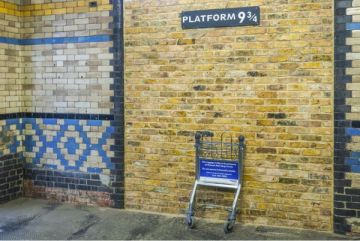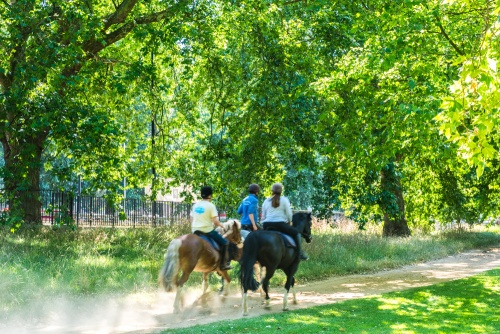
Hyde Park is one of 8 royal parks in the Greater London area, and covers over 350 acres, with a network of paths linking gardens, sculptures, fountains, and historic sites.
Once a hunting ground for Henry VIII, Hyde Park's character stems from the Serpentine Lake, home to waterfowl and sweating oarsmen. Rotten Row, on the southern boundary of the park, is a famous horse-riding area, and Speaker's Corner, by the Marble Arch entrance, is the place to listen to soap-box orators on Sunday mornings.
History
The area that now makes up Hyde Park was owned by the monks of Westminster Abbey until 1536 when Henry VIII had the Abbey suppressed. Henry used the park for hunting deer, and it remained a royal hunting ground until James I allowed limited public access in the early 17th century. Charles I opened the park to the public permanently in 1637. In 1665 many Londoners escaped from the horrors of the Great Plague and camped in Hyde Park.
Later monarchs changed the character of the park; William III created Rotten Row to provide a safe riding route between his home at Kensington Palace to the Palace of St James, and Queen Caroline, wife of George II, created the sinuous Serpentine lake.
Later monarchs made Hyde Park a centrepiece for national celebrations; the Prince Regent paid for fireworks here to celebrate the end of the Napoleonic Wars, and in 1851 Prince Albert organised the Great Exhibition, which spread out over large areas of Kensington Gardens and Hyde Park. Throughout the Victorian period, the park became a focal point for social protests, which huge gatherings by the Reform League and later, by suffragettes, gathering here. In 1977 Queen Elizabeth II's Silver Jubilee Exhibition was held in Hyde Park.
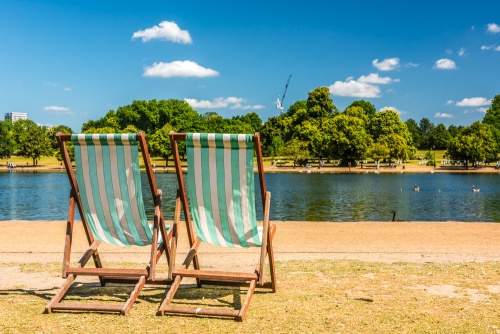
What to See
Apsley Gate
Many visitors to Hyde Park with pass through Apsley Gate, at Hyde Park Corner. This imposing stone gateway was designed by Decimus Burton (1800-1881), who also designed the nearby Wellington Arch. It was one of Burton's earliest commissions; he was just 25 years old at the time. He was one of the founding members of the Royal Institute of British Architects, and designed many of the London Zoo buildings as well as laying out the Royal Botanic Gardens at Kew.
The gateway is made of cream-coloured Portland stone and was begun in 1826. It took three years to complete. It is decorated with neo-classical friezes copied from the Elgin Marbles in the British Museum. Burton also designed the lodge just inside the gates. Look for the turret clock atop the lodge house.
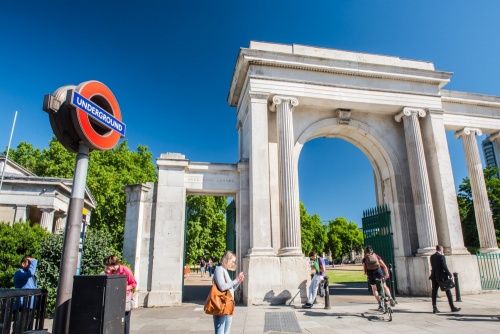
Queen Elizabeth Gate
Just a short walk from the Apsley Gates is another, much more modern, set of gates, designed to commemorate the 90th birthday of Queen Elizabeth the Queen Mother. The gates were paid for by public subscription and were opened by the Queen in 1993. They are made from stainless steel and incorporate the lion of England and the unicorn of Scotland in the central gateway panel. It is fair to say that the gate design did not meet with uniform approval; one critic described them as 'a music hall joke'.
Achilles Statue
Within sight of the Queen Elizabeth Gate is this huge statue of Achilles, created to commemorate the life of Arthur Wellesley, 1st Duke of Wellington and the victor of Waterloo. The gargantuan statue stands 18-feet high and was the very first statue installed in Hyde Park. It was created with money given by a group of high society women known as The Ladies of England, and installed in Hyde Park on the orders of King George III (though not actually installed until 1822, in the reign of his son, George IV).
The sculptor was Sir Richard Westmacott, who melted down 33 French cannons captured by Wellington during his campaigns in France. The figure of Achilles is based on a Roman statue discovered at Monte Cavallo, but the head is a likeness of Wellington. Westmacott's original statue was completely nude, but when the figure was unveiled it caused an uproar, so the sculptor had to quickly add a fig leaf to preserve the Duke's modesty.
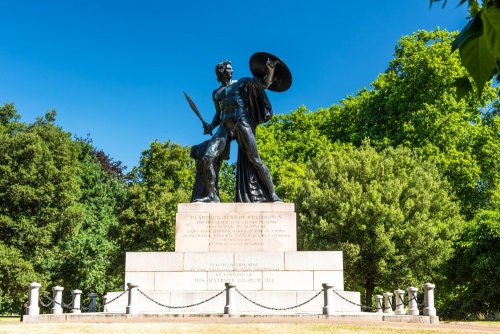
Little Nell
No one seems to know quite why this statue of a naked girl carrying a fish is dubbed 'Little Nell', which suggests a connection to the Charles Dickens character Nell Trent, the heroine of his novel The Old Curiosity Shop.
The statue and the fountain on which it stands were sculpted around 1897 by William Colton, RA, and seems to have been originally called the Mermaid Fountain, and more recently, The Colton Memorial. Colton was also responsible for the Boer War Memorial to the Royal Artillery in St James' Park. The figure we see today is a copy of the original, made of concrete and erected in 1975.
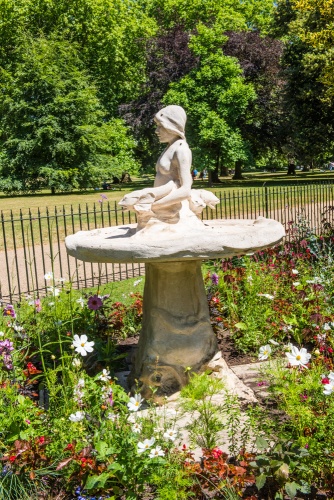
Rotten Row
Along the southern edge of Hyde Park runs a broad track linking Hyde Park Corner to Serpentine Road. This is Rotten Row, and it was a popular area for well-to-do Londoners to ride their horses during the 18th and 19th centuries. The unusual name comes from an English mangling of the French phrase Route du Roi, or King's Road.
Rotten Row owes its existence to William III, who wanted to create a safe route to travel between Kensington Palace and St James Palace. To illuminate the route William had 300 oil lamps installed in 1690, making Rotten Row the first artificially illuminated highway in Britain.
During the 18th century, fashionable Londoners made Rotten Row a popular meeting place, a place to see and be seen. Horse riders donned their best outfits and exercised their steeds along the route, while more sedate members of high society drove their carriages along neighbouring South Carriage Drive.
Today you can still see occasional horses being ridden along Rotten Row, but it is no longer heavily used. Look for a plaque beside the track with the inscription,
'This ride originally formed part of King William III's carriage drive from Whitehall to Kensington Palace. Its Construction was supervised by the Surveyor of their Majesties' Roads, Captain Michael Studholme and it was the first lamp-lit road in the Kingdom. Designated as a public bridleway in the 1730s, Rotten Row is one of the most famous urban riding grounds in the world'.
The plaque was erected in 1990 to mark the 300th anniversary of Rotten Row.
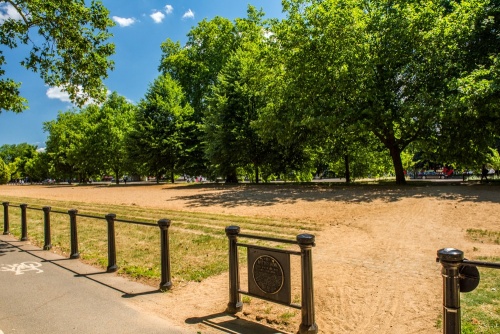
Speakers' Corner
This famous area of Hyde Park lies in the north-eastern corner of the park, facing Marble Arch. An Act of Parliament in 1872 declared this corner of the park an area for public speaking. Speakers' Corner gained an almost mythical status over the years as a place where anyone could say anything they wanted on any subject, without fear of censure or legal repercussion, making Speakers' Corner an important place in the concept of free speech.
The myth is not strictly true; though speakers are allowed to speak on any subject, their speeches do have to be considered lawful by the police, which is a rather vague term open to interpretation.
Speakers usually harangue passing crowds on Sunday mornings, and at other times of the week you will usually find Speakers' Corner to be an unremarkable area of the park.
The history of Speakers' Corner goes back to the year 1196, when the infamous Tyburn Gallows were set up near this spot. You can see a plaque marking the gallows location set into the pavement on the far side of Oxford Street, opposite Marble Arch. Over the centuries some 50,000 people were hanged at Tyburn until the Gallows were finally taken down in 1783.
People condemned to die at Tyburn were permitted to make a speech to the assembled onlookers before their execution. Some used the opportunity to repent their crimes, others protested their innocence, and some criticised the authorities that had condemned them to die. The connection of Tyburn to public protest was firmly ingrained in the public mind by the time executions were moved from Tyburn to Newgate Prison.
The tradition continued after the Gallows were removed, and protest marches often ended at what is now Speakers' Corner. In 1866 a march by the Reform League, demanding an extension of voting rights, ended in violence when the government tried to stop protestors from entering Hyde Park. Three days of rioting ensued.
Another protest the following year drew 150,000 marchers and forced the Home Secretary to resign. The government saw the wisdom of permitting controlled freedom of speech in a designated area of the park, and in 1872 enacted the Parks Regulation Act, granting the right to meet and speak freely in Hyde Park, as long as they didn't use obscene language.
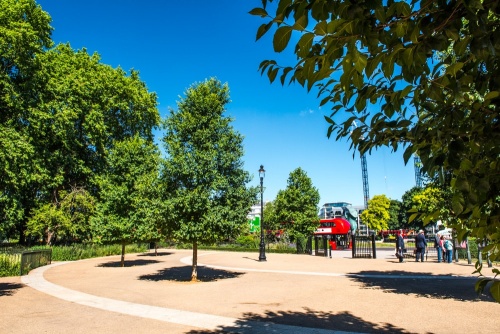
The Reformers' Tree
The park continued as a popular destination for protest marchers even after Speakers' Corner was established. From 1906-14 the suffragettes held regular meetings near The Reformers Tree in the south-west corner of the parade ground.
It was a consciously ironic choice of venue, for the tree had gained its name from the fact that the Reform League, demanding the vote for all men, but not women, gathered at the tree in 1866. The tree was set on fire during one protest, and its stump became a focal point for further protests and a symbol of people's right to free speech and free assembly. The stump is long gone, and in its place is a circular mosaic with the outline of a black tree against a white background.
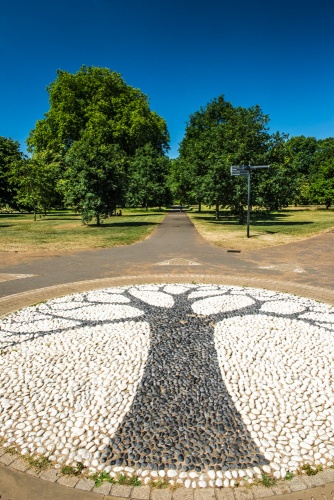
Marble Arch
Just beyond Speakers' Corner, in the north-east corner of Hyde Park, stands Marble Arch, designed by John Nash as a ceremonial entrance to the courtyard at Buckingham Palace. The original design called for the archway to be topped by a statue of George IV, Nash's patron, but rising costs and the king's death meant that the finished design was less elaborate and omitted the sculpture completely.
It was moved in 1851 to its present, rather oddly isolated location on what is now a large traffic island at the junction of Park Lane and Oxford Road. In theory, only the royal family and the King's Troop, Royal Horse Artillery are allowed to pass through the central archway.
I say, in theory, because the archway is open and pedestrians pass through it all the time. The arch is modelled after the Arch of Constantine in Rome and the Arc de Triomphe in Paris. It is made of stone faced with Italian marble.
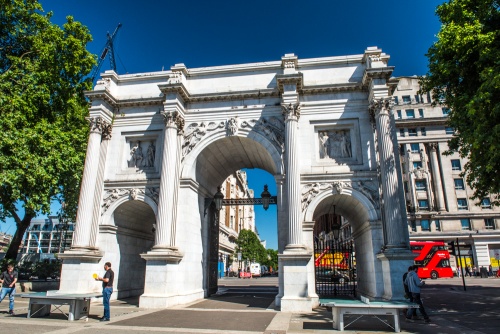
Rose Garden
Close to Hyde Park Corner in the south-eastern corner of the park is a colourful garden area laid out in 1994. The garden is bounded by yew trees and planted with seasonal flower beds. The combination of yew borders and flower beds is designed to resemble musical notes emerging from a trumpet's mouth. The roses are at their best in the summer months, but the seasonal planting means the garden is a pleasant space to enjoy at any time of year.
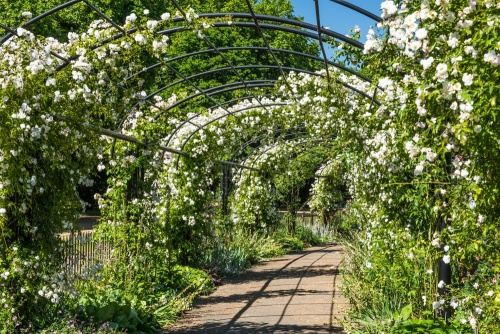
Boy and Dolphin Fountain
Two statues grace the Rose Garden. The first is the Boy and Dolphin Fountain, sculpted by Alexander Munro in 1862. Munro was a friend of Lewis Carroll, author of the Alice in Wonderland books. The fountain was made for a Victorian sunken garden that had to be destroyed to make way for a widening of Park Lane. The fountain was moved to Regents Park in 1962 but was returned to Hyde Park in 1995. In a curious twist, the site of the Victorian sunken garden now holds the modern Joy of Life Fountain.
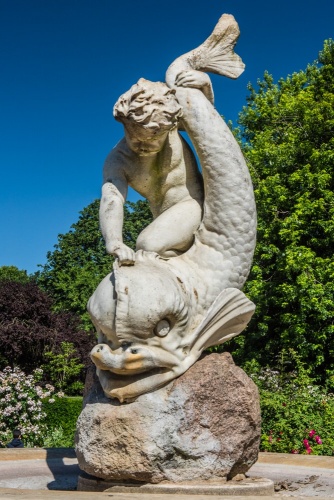
Diana the Huntress Fountain
The other statue in the rose garden is the Diana the Huntress Fountain (not to be confused with the Diana, Princess of Wales Memorial Fountain further west). It shows a nude figure of Diana, the goddess of hunting, drawing her bow. The Huntress Fountain was created by Lady Feodora Gleichen in 1899. Lady Gleichen was the first female member of the Royal British Society of Sculptors. The fountain was donated by Sir Walter and Lady Palmer and installed in 1906.
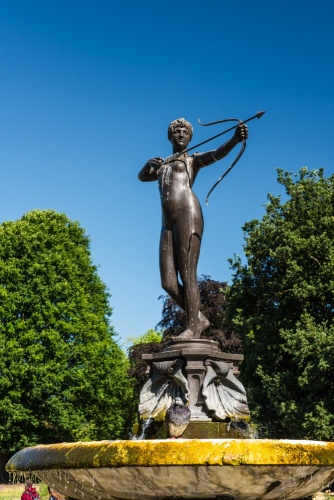
Diana Princess of Wales Memorial Fountain
One of the most popular visitor attractions in Hyde Park is this striking water feature, officially opened by Her Majesty the Queen on 6 July 2004, in memory of Princess Diana. To call it a fountain is a bit misleading; it is a watercourse made of Cornish granite. Water flows in two directions from the highest point, down cascades and over shallows to a deep pool at the base. The design is meant to reflect the popular Princess's life. You will often find delighted small children wading along the watercourse or splashing in the pool, filling the air with their shrieks of happiness. I think Princess Diana would have approved.
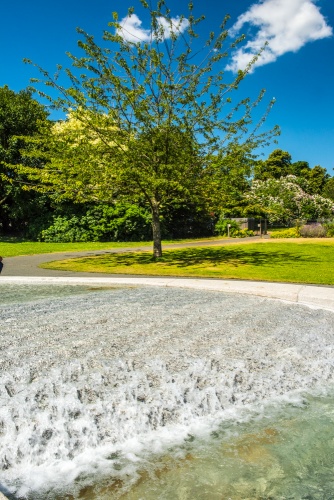
Serenity Statue (Isis Sculpture)
Immediately north of the Diana Memorial Fountain is this striking bronze sculpture of a bird, inspired by the Egyptian symbol for the goddess of nature. The sculpture was created by Simon Gudgeon and was installed in 2009. The sculpture was donated by the Halcyon Gallery as part of a campaign to raise money for educational outreach projects in Hyde Park. You can see donor's plaques arranged at the foot of the sculpture, which stands beside the south bank of the Serpentine.
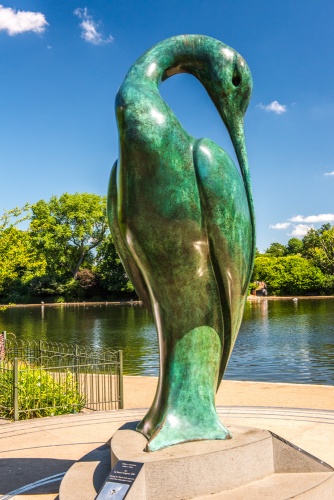
Pan Statue
One of the park's lesser-known statues, but only because it is tucked away on South Carriage Drive, away from the main visitors' paths. The bronze sculpture is also known as Rush of Green and depicts a family and their dog rushing towards the park, while Pan plays his pipes to urge them on. The statue was designed by Sir Jacob Epstein, one of Britain's most influential 20th-century artists. It stands near the Edinburgh Gate to the park.
Household Cavalry Memorial
Also on South Carriage Drive is a memorial to 4 members of the Blues and Royals who lost their lives when an IRA bomb exploded on 20 July 1982. Twelve soldiers and six civilians were injured and seven horses died when the bomb was set off while the Queen's Life Guard was passing.
In memory of the four guardsmen who died, every time the Queen's Life Guard or other body of the Household Cavalry pass the memorial they bring their swords down to the carry position and observe 'eyes right' or 'eyes left' to focus on the memorial. Also, any band approaching the site ceases playing until they have passed.
Just to be confusing, this memorial is shown on some maps of Hyde Park as the Cavalry Memorial, but since there is another Cavalry Memorial in the park, we've given this site a more accurate label.
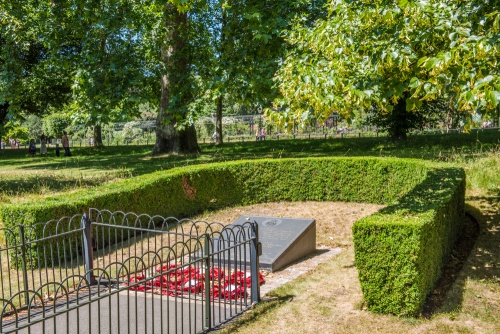
Norwegian War Memorial
North of the Serpentine, opposite the West Boathouse, stands this large granite boulder, given by the Norwegian Navy and Merchant Fleet in 1978 as a mark of gratitude to the British people for their support during WWII. Both the front and rear faces of the stone are engraved. The front face reads, 'You gave us a safe haven in our common struggle for freedom and peace', while the rear is carved with the words, 'Worked and shaped by forces of nature for thousands of years'.
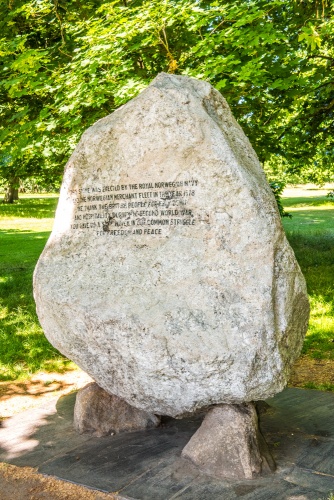
Cavalry Memorial
Near Hyde Park Corner in the south-east corner of the park is a bronze sculpture depicting St George on horseback, above a defeated dragon. The memorial was raised to commemorate members of the Cavalry Regiments who lost their lives in WWI. Around the base of the memorial is a frieze showing galloping horsemen.
The sculpture was designed by Adrian Jones, himself an army veteran, and was made with bronze from guns captured during the war. The frieze around the base was added by Sir John Burnet, and the memorial was installed in 1924. Its original location was close to the Stanhope Gate but in 1961 it was moved to its current location near the Bandstand when Park Lane was widened.
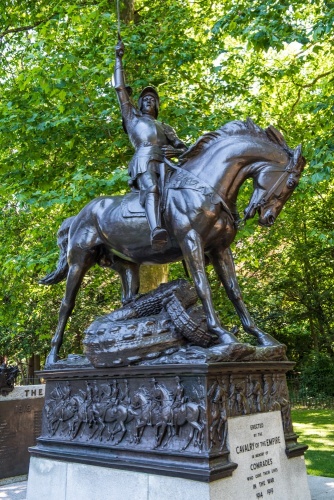
Holocaust Memorial
Close to the east end of the Serpentine, set in a grove of birch trees, stands Britain's first memorial to the victims of the Holocaust. The memorial was created in 1983 and was a gift of the Board of British Jews. It was created by Richard Seifert with David Lovejoy and Partners. The memorial takes the form of a garden of granite boulders. The largest boulder is inscribed with a verse from Lamentations that runs, 'For these I weep. Streams of tears flow from my eyes because of the destruction of my people'.
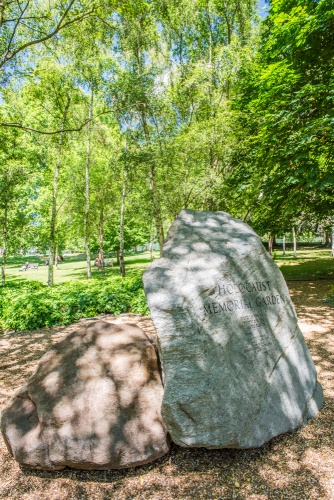
7 July Memorial
The most modern and one of the most moving memorials in Hyde Park is this sculpture commemorating the victims of the 7 July 2005 London bombings. The memorial was unveiled by Their Royal Highnesses, The Prince of Wales and The Duchess of Cornwall on 7 July 2009, exactly 4 years after 52 people lost their lives to terrorist bombs.
The memorial is in the south-east corner of the park, north of Hyde Park Corner and fairly close to the Achilles Statue. The striking memorial is composed of 52 slender pillars made of stainless steel, one for each of the victims. The pillars are arranged in four groups, one for each location where bombs were set off. Each pillar is marked with a date and time plaque. A further plaque with the victim's names is set on a grassy bank at the eastern edge of the memorial site.
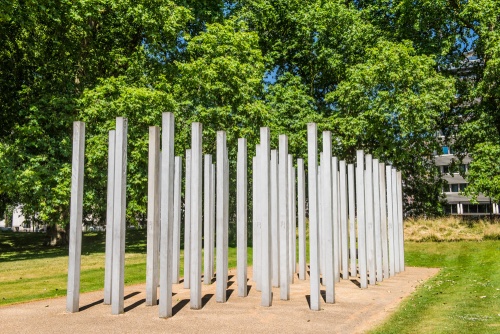
The Hyde Park Bandstand
Between Hyde Park Corner and the eastern end of the Serpentine is one of the oldest public bandstands in England. It was erected in 1869 and was originally located in neighbouring Kensington Gardens. In 1886 it was moved to its present location in Hyde Park. Its octagonal roof gives it very good acoustical qualities. In the 1890s it was used for concerts three times a week and it is still used today for occasional performances.
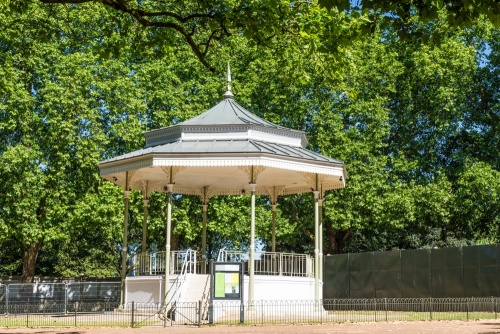
Hudson Memorial Bird Sanctuary
One of the easiest memorials to overlook in Hyde Park, this combination memorial and bird sanctuary is located north of the Serpentine and east of West Carriage Drive. It commemorates the Victorian naturalist and author William Hudson, who helped found the Royal Society for the Protection of Birds (RSPB). Hudson campaigned long and hard to establish wild areas in public parks, to provide areas for wildlife and birds to live.
The memorial is based around a carving by Sir Jacob Epstein, depicting the child goddess Rima, who appeared in Hudson's 1904 novel Green Mansions.
The memorial was controversial when it was unveiled in 1924. The Daily Mail, never a publication to steer clear of controversy, pleaded, 'take this horror out of our park', but here it stays. The memorial is set in a wooded area created as a habitat for small birds.
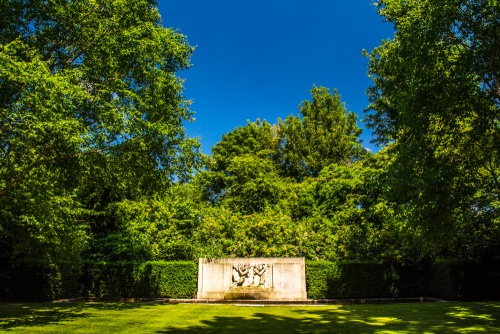
Queen Caroline Memorial
Almost hidden in foliage beside the eastern end of the Serpentine pond is this neo-classical memorial to Queen Caroline, wife of George II. Queen Caroline helped create the Serpentine in Hyde Park and the Long Water in Kensington Gardens over the years 1726-1730. Her memorial takes the form of an urn mounted on a stone plinth. The memorial was officially unveiled by HM Queen Elizabeth in 1990.
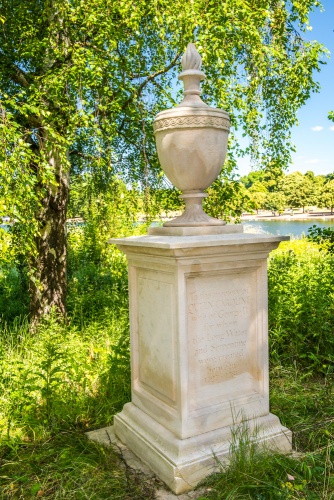
Joy of Life Fountain
In the 1860s the area beside Park Lane on the eastern edge of Hyde Park was given over to a sunken garden. The sunken garden was removed when Park Lane was widened and the Boy and Dolphin fountain had to be moved. In 1963 TB Huxley-Jones designed a new fountain, depicting a pair of bronze figures dancing above a pool of water while four children emerge from the water. In 2008 the Marie Curie Cancer Care charity planted some 80,000 daffodil bulbs around the fountain as part of celebrations marking their 60th anniversary.
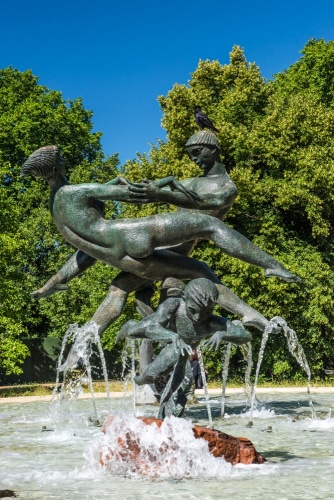
Animals in War Memorial
Technically still inside the park boundary, this striking memorial stands on a traffic island in the middle of Park Lane, on the eastern edge of the park. The memorial marks the contribution of animals that served and died beside British troops during 20th-century conflicts.
The touching memorial shows animals large and small struggling through a gap in a curving wall of Portland stone. The silhouettes of more animals are carved onto the wall, while a touching inscription reads simply, 'They had no choice'. The memorial was prompted by the Jilly Cooper novel Animals in War and was unveiled in 2004 on the 90th anniversary of the outbreak of WWII.
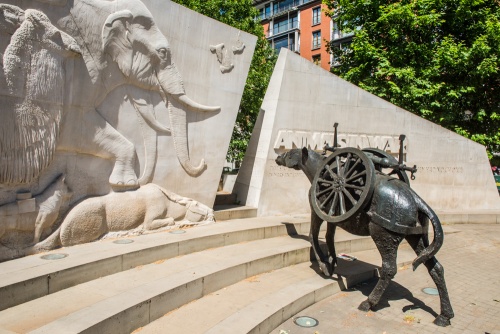
The Serpentine
At the heart of Hyde Park lies The Serpentine, a 40-acre lake created in 1730 on the orders of Queen Caroline, wife of George II. The lake takes its name from its curving shape, which resembles a snake in its sinuous curves. It was created by damming the River Westbourne and Tyburn Brook, causing flooding that linked several medieval monastic ponds.
Technically speaking, the Serpentine is only the eastern half of the lake while the western half, in neighbouring Kensington Gardens, is called the Long Water. The lake offers several recreational facilities including boating and swimming. Every Christmas morning The Serpentine hosts the Peter Pan Cup, a 100-yard swimming race first held in 1864.
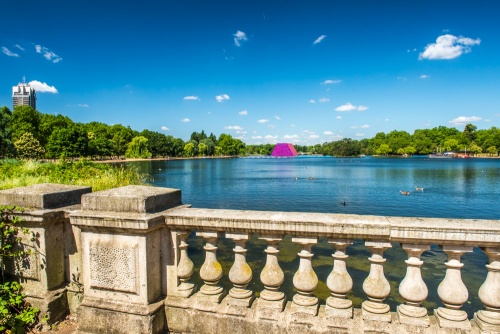
Serpentine Bridge
This iconic multi-arched bridge carries West Carriage Drive over The Serpentine and acts as a boundary between Hyde Park to the east and Kensington Gardens to the west. The bridge was erected in 1820 to a design by architect John Rennie.
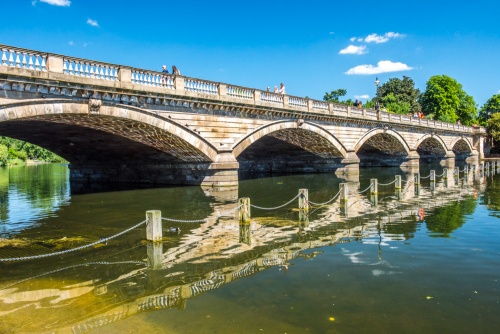
Serpentine Gallery
There are two popular galleries, both free to enter, about 5 minutes walk apart, linked by the Serpentine Bridge. The original Serpentine Gallery was opened in 1970 and occupies a former tea pavilion built in 1934. In 2013 a Napoleonic War gunpowder store known as The Magazine was transformed into a second gallery known as the Serpentine Sackler Gallery. Technically, the original Serpentine Gallery is in Kensington Gardens, while the more recent gallery - housed in a much older listed building - is within Hyde Park.
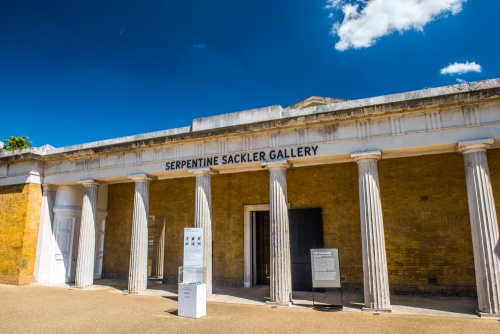
Great Exhibition Site
On 1 May 1851 The Great Exhibition of the Works of Industry of All Nations opened in Hyde Park. The Great Exhibition was the brainchild of Prince Albert, Queen Victoria's consort. The exhibition hall was a temporary iron and glass structure dubbed 'The Crystal Palace', designed by Joseph Paxton. The exhibition showcased design and industry from 25 countries and was a huge commercial success.
Many of the items on display were used to create the South Kensington Museum, the forerunner of the Victoria and Albert Museum. Today the exhibition site is a large, empty field known as The Old Football Pitches, between South Carriage Drive and Rotten Row, its history outlined by a plaque and an information panel.
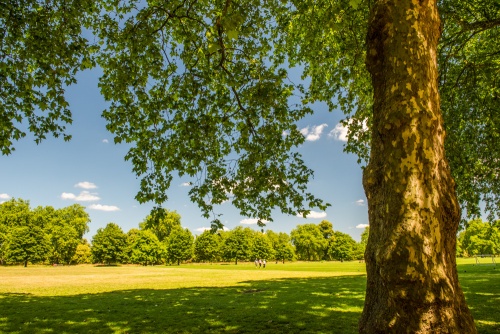
Directions to Hyde Park
The park is bounded on the north by Bayswater Road and on the south by Kensington Gore and Knightsbridge. Park Lane runs along the eastern boundary, and the West Carriage Drive marks - for the most part - the park's western boundary.
Since the park is so big there are numerous places to access it. For Hyde Park Corner (the south-eastern corner), the closest tube station is Hyde Park Corner (Piccadilly Line), while Marble Arch tube station (Central Line) is the closest to, well, Marble Arch, Speakers Corner, and the north-east corner of the park.
Lancaster Gate station (Central Line) is closest to the north-west corner, where the park joins Kensington Gardens, and Knightsbridge station (Piccadilly Line) is closest to The Serpentine and the Diana Princess of Wales Fountain in the south-west corner of the park.
There is limited car parking at either end of Serpentine Bridge and along West Carriage Drive. However, due to the very limited number of spaces it really isn't a great idea to rely on getting a parking spot. Public transport is a much more sensible option.
Hyde Park is open from 5am until midnight throughout the year.
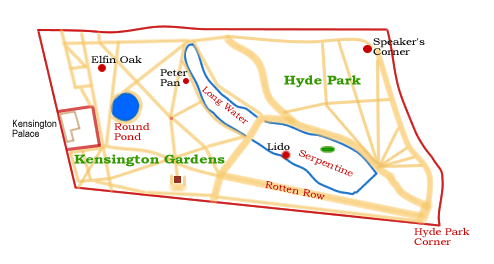
See also
Kensington Gardens
More London Parks
About Hyde Park
Address: Hyde Park Office, Rangers Lodge, London,
Greater London,
England, W2 2UH
Attraction Type: Park
Location: For Hyde Park Corner (Apsley Gate) use Hyde Park Corner tube, for Marble Arch and Speakers Corner use Marble Arch tube.
Website: Hyde Park
Email: hyde@royalparks.org.uk
Location
map
OS: TQ274803
Photo Credit: David Ross and Britain Express
Nearest station: ![]() Knightsbridge - 0.5 miles (straight line) - Zone: 1
Knightsbridge - 0.5 miles (straight line) - Zone: 1
HERITAGE
 We've 'tagged' this attraction information to help you find related historic attractions and learn more about major time periods mentioned.
We've 'tagged' this attraction information to help you find related historic attractions and learn more about major time periods mentioned.
Find other attractions tagged with:
NEARBY HISTORIC ATTRACTIONS
Heritage Rated from 1- 5 (low to exceptional) on historic interest
Marble Arch - 0.4 miles (Historic Building) ![]()
Apsley House - 0.6 miles (Historic House) ![]()
Albert Memorial - 0.7 miles (Historic Building) ![]()
Kensington Gardens - 0.7 miles (Park) ![]()
Wellington Arch - 0.7 miles (Historic Building) ![]()
Alexander Fleming Laboratory Museum - 0.7 miles (Museum) ![]()
Brompton Oratory - 0.7 miles (Historic Church) ![]()
Victoria and Albert Museum - 0.8 miles (Museum) ![]()
Nearest Holiday Cottages to Hyde Park:
Leaves Green, Greater London
Sleeps: 6
Stay from: £871 - 3614
Holmbury St Mary, Surrey
Sleeps: 9
Stay from: £842 - 4619
More self catering near Hyde Park



